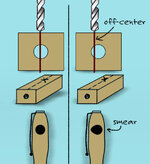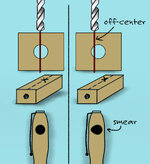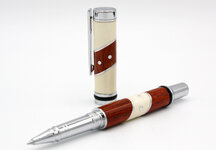Wmcullen
Member
I'm not sure if this process is right or wrong; unique or common. But it works for me and I want to share in case it's interesting. |
I could have pretended it was intentional... but it wasn't and it bothered me.
The Problem
The holes I drilled were off-center.
My impatience and imprecision yielded poor results and I realized my first pen's success was just luck.
Here's my new process
(Not rocket surgery, just how I do it.)
I decided it's better to drill into blanks that are "roughly" turned round.
It just seems easier to gauge where the center is.
For smaller holes, I can "eye-ball" it and everything works just fine.
But larger holes may need another solution.
Solution #2: Overkill
To be more precise, I use a jig that clamps to the base of my drill press. (File attached.)
It has a classic v-shape trench to hold the cylinder still. And I added a swinging measuring arm to identify the center.
Using this in combination with my drill press's laser finder means I can hit the center accurately.
Here's what it looks like in real life:
Summary
For my pens, precision is a matter of perception. How exact does it need to be to look good?
It's nice to have a range of options available when trying to appear precise: everything from "quick and dirty eye-balling" to "carefully measured and deliberate."
-Cullen
About the 3d Jig file
The geometry (*.obj file) for this Center Finding Jig is attached as a *.zip file called "centerDrillJig.zip."
It consists of two pieces: the base and the arm.
I used a steel rivet for the arm pivot.
The holes the rivet pass through will probably need to be re-drilled carefully.



